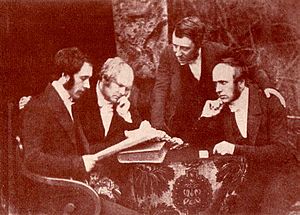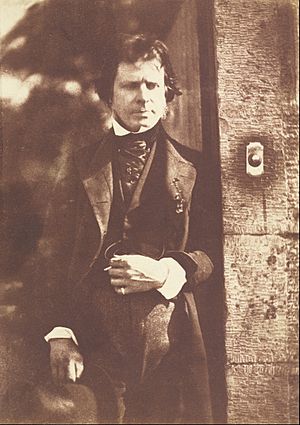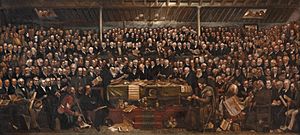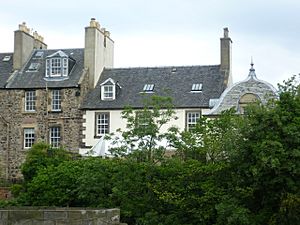David Octavius Hill facts for kids
David Octavius Hill (born May 20, 1802 – died May 17, 1870) was a Scottish artist. He was a painter, photographer, and also worked to support the arts. He started a photography studio called Hill & Adamson with engineer and photographer Robert Adamson. Together, from 1843 to 1847, they helped create many new ways of taking photos in Scotland.
Contents
Early Life and Art
David Octavius Hill was born in 1802 in Perth. His father was a bookseller and publisher. He helped restart Perth Academy, where David and his brothers went to school. Later, David moved to Edinburgh to study at the School of Design.
He learned a printing method called lithography. He created a book of pictures called Sketches of Scenery in Perthshire. His landscape paintings were shown in art exhibitions. Hill and other artists were not happy with the main art group. So, they started their own group called the Scottish Academy in 1829. Hill became its unpaid secretary a year later.
He also drew pictures for books. For example, he illustrated books by famous writers like Walter Scott and Robert Burns. In 1836, the Royal Scottish Academy started paying him a salary. With this steady income, he married Ann Macdonald in 1837. They had a daughter named Charlotte. Ann passed away in 1841.
Hill kept painting landscapes and creating illustrations.
A Big Painting and New Photography

In 1843, Hill saw a very important event called the Disruption of 1843. This was when over 450 ministers left the main Church of Scotland to start a new church, the Free Church of Scotland. Hill decided to paint this dramatic scene.
His friend, Lord Cockburn, and a scientist named Sir David Brewster encouraged him. Brewster suggested using a new invention: photography! Photography was very new, only invented in 1839. Brewster introduced Hill to Robert Adamson, who was also interested in photography.
Hill and Adamson took many photographs of the ministers and the place where the event happened. These photos helped Hill create his huge painting. The painting was very big, about 5 feet by 11.4 feet. He finally finished it in 1866.
The Photography Studio
Hill and Adamson worked very well together. Hill was good at planning the pictures and using light. Adamson was skilled at using the camera. Their partnership was a big success. They soon started taking photos of many different things.
Adamson's studio, called "Rock House," was on Calton Hill in Edinburgh. This became the center of their photography work. They used an early photography method called the calotype process. They took many portraits of famous Scottish people of that time, like Hugh Miller. They photographed them both in the studio and outdoors, sometimes among the old tombs in Greyfriars Kirkyard.
They also photographed landscapes in Scotland and city scenes. They even took pictures of the Scott Monument while it was being built in Edinburgh. Besides famous people, they photographed everyday working people. They especially liked to photograph the fishermen of Newhaven and the fishwives. These fishwives carried fish in large baskets called creels about 3 miles uphill to Edinburgh to sell them.
Hill and Adamson created around 3,000 photographs together. Sadly, their partnership ended after only four years. Adamson became ill and passed away in 1848. The early calotype photos would fade if left in sunlight, so they had to be kept in albums.
Hill continued the studio for a few months but became less active in photography. He still sold prints of their photos and used them to help him with his paintings. In 1862, he married again to a sculptor named Amelia Robertson Paton. Around this time, he started taking photos again. However, these new photos were not as lively as the ones he made with Adamson.
He was very sad after his daughter passed away, and his work slowed down. In 1866, he finally finished his famous "Disruption" painting. It received a lot of praise, even though many of the people in the painting had already died. In 1869, he had to stop working as the secretary for the Royal Scottish Academy due to illness. He passed away in May 1870.
Hill is buried in Dean Cemetery in Edinburgh. His second wife, Amelia, sculpted a bust of him that is on his grave. She is buried next to him.
Exhibitions
Some of David Octavius Hill's photographs were shown in Glasgow in 1954. The first big exhibition of his work was in 1963 in Essen, Germany.
Images for kids
-
Fishwives in St Andrews bait their lines, 1844.
-
Newhaven fishergirls pose with a creel
(between 1843 and 1847) -
The Pier at Leith, a painting by David Octavius Hill c.1860











